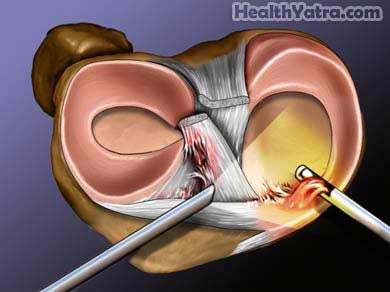تعريف
Meniscus is cartilage in the knee joint. It helps to stabilize and cushion the knee. A meniscectomy is the removal of all or part of the meniscus.

أسباب هذا الإجراء
A meniscectomy is done when the cartilage is damaged. Damaged cartilage can cause pain, or give you problems with knee motion.
المضاعفات المحتملة
المشاكل من هذا الإجراء نادرة ، لكن جميع الإجراءات تنطوي على بعض المخاطر. سيراجع طبيبك المشاكل المحتملة ، مثل:
- العدوى
- Excess bleeding
- تورم
- Blood clots
- Chronic weakness in knee joint
- Worsening or unchanged pain
تشمل العوامل التي قد تزيد من خطر حدوث مضاعفات ما يلي:
- التدخين
- سوء التغذية
- History of blood clots
- Long-term illness
- استخدام بعض الأدوية
ما يمكن توقعه
قبل الإجراء
قد يقوم طبيبك بما يلي:
- اختبار بدني
- فحص الدم
- الأشعة السينية
- MRI to get images of the internal structure of the knee
Talk to your doctor about your medications. You may be asked to stop taking some medications up to one week before the procedure, like:
- Aspirin and other anti-inflammatory drugs
- Blood-thinning drugs, such as warfarin
- Anti-platelet drugs, such as clopidogrel
لا تأكل أو تشرب أي شيء بعد منتصف الليل في اليوم السابق لعملية الجراحة، ما لم يخبرك طبيبك بخلاف ذلك.
التخدير
Anesthesia will keep you pain-free and comfortable during the procedure. Depending on the procedure, anesthesia may be:
- Local—the area around the knee will be numbed
- Spinal—your lower body will be numbed from an injection into the back
- General anesthesia—you will be asleep
وصف الإجراء
There are two methods for meniscectomy. The more common procedure is called arthoscopy. Arthrotomy, an open technique, is rarely used. This may also be referred to as an open meniscectomy.
تنظير المفاصل
Small incisions are made around the knee. Special tools are inserted into the knee joint. A tiny camera will provide a view of the inside of the knee. The damaged meniscus is either repaired or removed. The doctor will remove as little cartilage as possible. A drain may be inserted to drain away fluid. The incisions are closed with stitches. The stitches are usually removed in the doctor’s office one week later.
Arthrotomy
A larger incision is made over the knee joint. The meniscus is then either repaired or removed. The incision is closed with stitches. It usually results in a longer recovery period. This process is usually done when there are problems with the knee that make the arthroscopic procedure difficult.
كم من الوقت سيستغرق ؟
The procedure usually takes less than one hour.
كم هو مؤلم ؟
Anesthesia will block pain during the procedure. You will have pain after the procedure. Ask your doctor about medication to help manage pain.
رعاية ما بعد العملية
في مركز الرعاية
Right after the procedure, the staff will monitor your recovery. The staff may give you:
- Pain medication
- المضادات الحيوية لمنع العدوى
- Medication that prevents blood clots
في البيت
- Use compression and ice for 48-72 hours after surgery. This will help reduce swelling.
- Elevate legs often while resting in bed.
- Use crutches or knee splint as directed by your doctor.
- Do exercises as recommended. You may start with simple thigh muscle exercises the day after surgery. More strengthening exercises will be added later.
- Take pain medications and all other prescribed medications as recommended by your doctor.
- اسأل طبيبك حول, عندما هي آمنة للاستحمام, السباحة, أو نقع في الماء.
- تأكد من اتباع تعليمات طبيبك.
If the meniscus was removed, it generally takes 3-6 weeks to return to full activities.
If the cartilage was repaired, it can take up to four months for full recovery. The goal of the first week is to reduce pain and swelling. After this, the goals are to increase range of motion and weight-bearing. Physical therapy is often done several times a week for four weeks or more. At 6-8 weeks, low impact activities can often be added. This will help to prepare you to return to sports or activities. Running, cutting, and rotation are avoided for at least 16 weeks.
استدعاء الطبيب
Call your doctor if any of the following occurs:
- علامات الإصابة, بما في ذلك حمى وقشعريرة
- احمرار أو تورم أو ألم متزايد أو نزيف مفرط أو إفرازات من موقع الشق
- Pain, redness, or swelling in either calf
- Pain that you cannot control with the medications you have been given
- استفراغ و غثيان
- Swollen, discolored, or cold toes
- السعال، ضيق التنفس، أو ألم في الصدر
- الأعراض الجديدة أو المتفاقمة
إذا كنت تعتقد أن لديك حالة طارئة ، فاتصل بالمساعدة الطبية على الفور.
